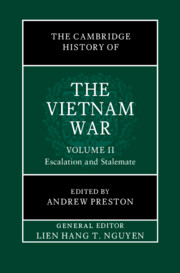Book contents
- The Cambridge History of the Vietnam War
- The Cambridge History of the Vietnam War
- The Cambridge History of the Vietnam War
- Copyright page
- Contents
- Figures
- Maps
- Tables
- Contributors to Volume II
- General Introduction
- Introduction
- Part I Battlefields
- 1 Reconsidering American Strategy in Vietnam
- 2 The Air Wars in Vietnam
- 3 US Combat Soldiers in Vietnam
- 4 American Women and the Vietnam War
- 5 The Conundrum of Pacification
- 6 The US Military Presence in South Vietnam
- 7 The ARVN Experience
- 8 The National Liberation Front
- 9 The People’s Army of Vietnam
- 10 Vietnamese Women and the War
- 11 Vietnam’s Ethnic Minorities at War
- 12 The War in Numbers
- 13 The Tet Offensive
- Part II Homefronts
- Part III Global Vietnam
- Index
11 - Vietnam’s Ethnic Minorities at War
from Part I - Battlefields
Published online by Cambridge University Press: 02 January 2025
- The Cambridge History of the Vietnam War
- The Cambridge History of the Vietnam War
- The Cambridge History of the Vietnam War
- Copyright page
- Contents
- Figures
- Maps
- Tables
- Contributors to Volume II
- General Introduction
- Introduction
- Part I Battlefields
- 1 Reconsidering American Strategy in Vietnam
- 2 The Air Wars in Vietnam
- 3 US Combat Soldiers in Vietnam
- 4 American Women and the Vietnam War
- 5 The Conundrum of Pacification
- 6 The US Military Presence in South Vietnam
- 7 The ARVN Experience
- 8 The National Liberation Front
- 9 The People’s Army of Vietnam
- 10 Vietnamese Women and the War
- 11 Vietnam’s Ethnic Minorities at War
- 12 The War in Numbers
- 13 The Tet Offensive
- Part II Homefronts
- Part III Global Vietnam
- Index
Summary
Until 1954 the strategically important Central Highlands were primarily inhabited by some twenty indigenous ethnic groups that the French and Americans collectively referred to as Montagnards or Highlanders. From 1960 the communist National Liberation Front sought to recruit Highlanders, leading to a rapid deterioration of the security situation in the Central Highlands, which in 1961 provoked the deployment of US Special Forces to lead Highlander militias. In combination with discriminatory policies of successive South Vietnamese governments, the militarization of the Highlands spurred the emergence in 1964 of a Highlands autonomy movement known as FULRO. As the Central Highlands became one of the main theaters of war, an attack by communist forces on an American airstrip close to Pleiku in the Central Highlands prompted the bombing campaign known as Operation Rolling Thunder and the landing of US combat troops near Da Nang in 1965. After a decade of forced resettlement and displacement of Highlanders, it was the silent complicity of FULRO militia and indigenous populations around the Highlands city of Ban Me Thuot that ensured the element of surprise in the attack by regular North Vietnamese cavalry in March 1975, triggering the collapse of the Republic of Vietnam one month later.
Keywords
- Type
- Chapter
- Information
- The Cambridge History of the Vietnam War , pp. 236 - 259Publisher: Cambridge University PressPrint publication year: 2024

